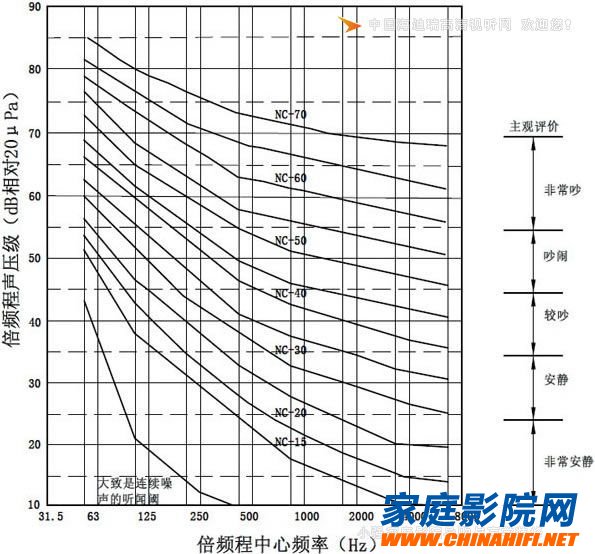1, grade and scope of application
For small theaters with a volume of less than or equal to 500m3, according to the objective technical indicators of small theaters, the comprehensive consideration of subjective certification indicators has established four levels for small theaters, namely:
Small Cinema Acoustic Certification Class B (not up to standard)
Small Cinema Acoustic Certification Level A (Standard Level)
Small Cinema Acoustic Certification A+ (Professional)
Small Cinema Acoustic Certification A++ (Laboratory)
2. Objective technical indicators
2.1 Background noise limit The upper limit is NC25 (noise source equipment is operating normally).
Quiet background noise is the premise and basis of sound quality design. Only when the room is quiet, can you experience every detail of the sound track, the sound quality design makes sense, otherwise the sound effect will be affected by external noise. Figure 1 shows the subjective feelings of the people corresponding to different NC curves.

Figure 1 different NC curves correspond to people's subjective feelings
Non-commercial theaters are generally more private and more personal, so they are more likely to be focused on appreciation without being disturbed by the outside world. To this end, based on the actual situation and reference to other countries' design indicators, select NC-25 (noise source equipment normal operation) as the background noise limit.
The control of background noise needs to be comprehensively considered from the aspects of room air sound insulation and impact sound insulation, ventilation and air conditioning equipment noise reduction, pipeline system sound insulation and vibration reduction, and indoor projection and playback equipment noise reduction.
2.2 air sound insulation
When the sound source emits white noise of 90 dB(A) or more indoors, the sound pressure level difference between adjacent sensitive rooms (horizontal and vertical) is greater than or equal to 45 dB (A).
Good sound insulation means that the room can be used at any time without disturbing others and without being disturbed by others. Taking a home theater as an example, the sound level range is about 85-105 dB(A) during normal screening. Therefore, good sound insulation is not only a guarantee of indoor background noise, but also an influence on the surrounding room and environment when the room is used.
In actual design, the wall is often composed of different components, such as doors and windows. Each component on the wall has different transmission loss, and the sound loss of the door and window is lower than other parts, resulting in a decrease in the sound insulation effect of the wall. The sound insulation of the combined wall is related to the sound insulation and the area of ​​the wall and the door and window. . Calculated as follows:

Where: Ï„ - the transmission coefficient of the composite wall;
Τw——the transmission coefficient of the wall;
Τd——the transmission coefficient of the door and window;
Sw - the area of ​​the wall;
Sd - the area of ​​the doors and windows.
The relationship between the sound insulation amount R and the transmission coefficient Ï„ can be calculated by the following formula:

In order to meet the above requirements, it is recommended that the sound insulation of the component air reaches: wall Rw+C≥60dB; floor Rw+C≥60dB; sound insulation door Rw+C≥45dB; sound insulation window Rw+C≥40dB.
Small theaters and audio-visual rooms have more low-frequency sounds during screening. Sound insulation should ensure the sound insulation of sounds below 250Hz. Multi-layer composite sound insulation boards can be used, with cavities, and elastic connections between the components. Equal sound insulation construction method.
This standard proposes a 45dB (A) sound level difference evaluation method, on the one hand is convenient for the actual evaluation work measurement operation, and the second is to propose that the sound insulation index is moderate and achievable, this indicator with 240 brick wall or The sound insulation performance of the 200 thick concrete wall is equivalent. In addition, the results of the evaluation measurements may be affected by the choice of measurement points, so the selection of the measurement points is specified in this standard.

2.3 IF reverberation time (500~1000Hz)
The indicators are as follows:
Small theater full field 500 ~ 1000Hz reverberation time
Note: The maximum error is allowed to be ±0.05s.
When the sound energy density reaches a steady state, if the sound source suddenly stops sounding, the sound at the indoor receiving point will not disappear immediately, but there will be a process of gradual decay, and the indoor sound energy density will gradually weaken until it approaches the background. This decay process is the "reverberation process."
In Ceiling Speakers,Silk Diaphragm Tweeter,In Wall Ceiling Speakers,Two Way In Ceiling Speakers
The ASI Audio Technology Co., Ltd , https://www.asi-sound.com